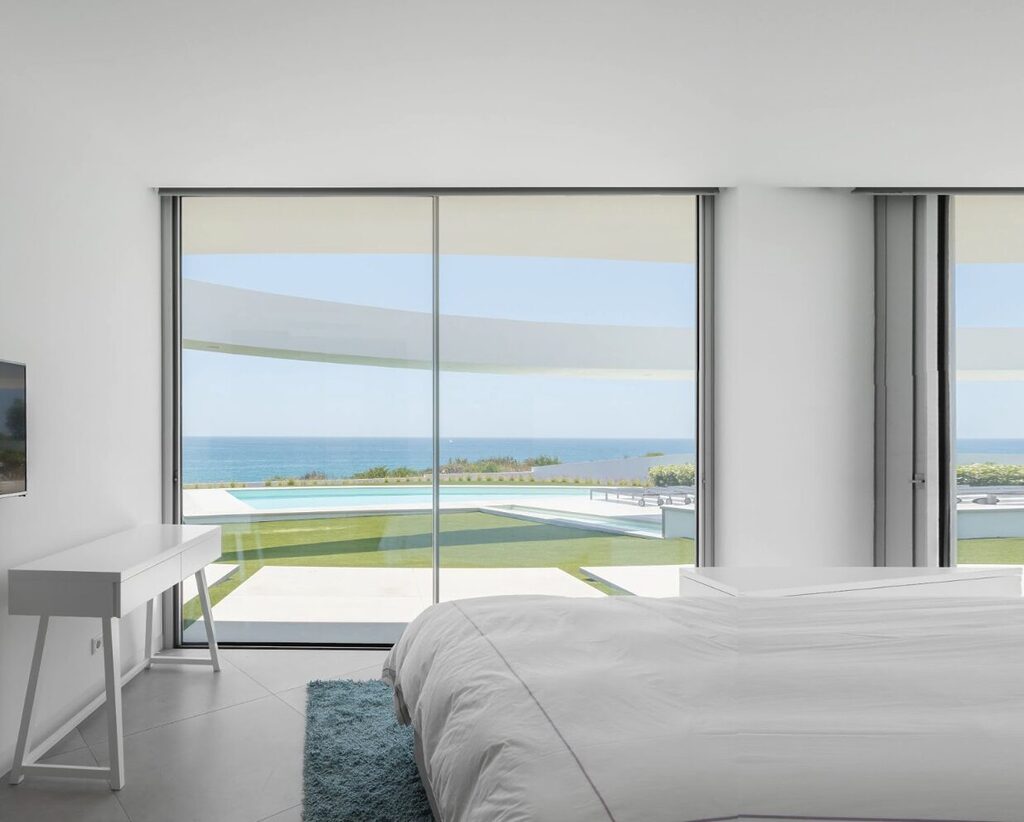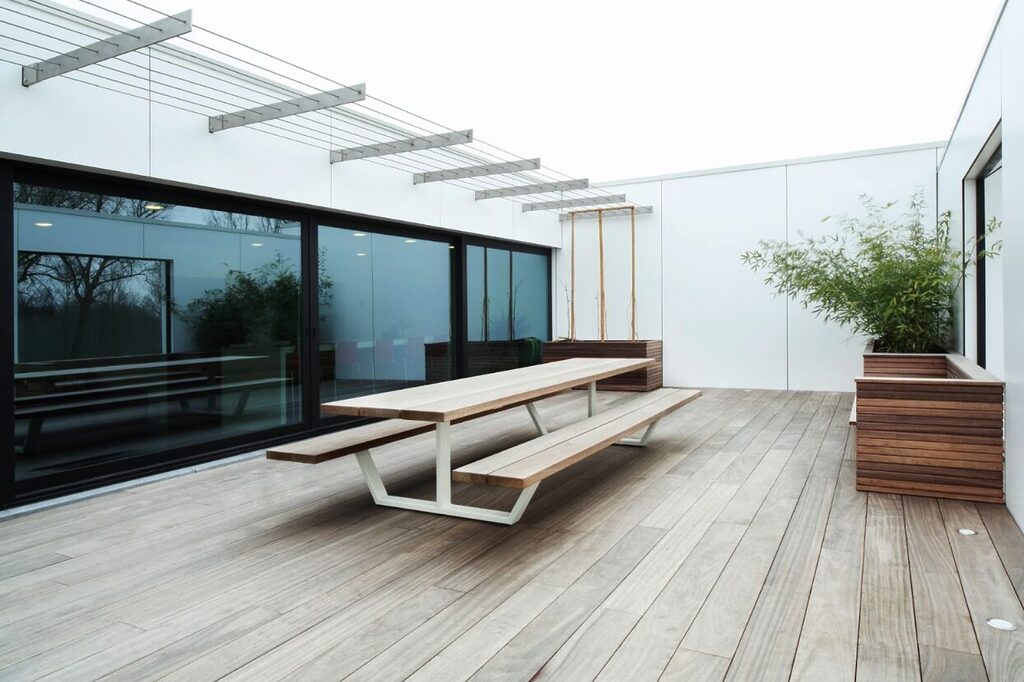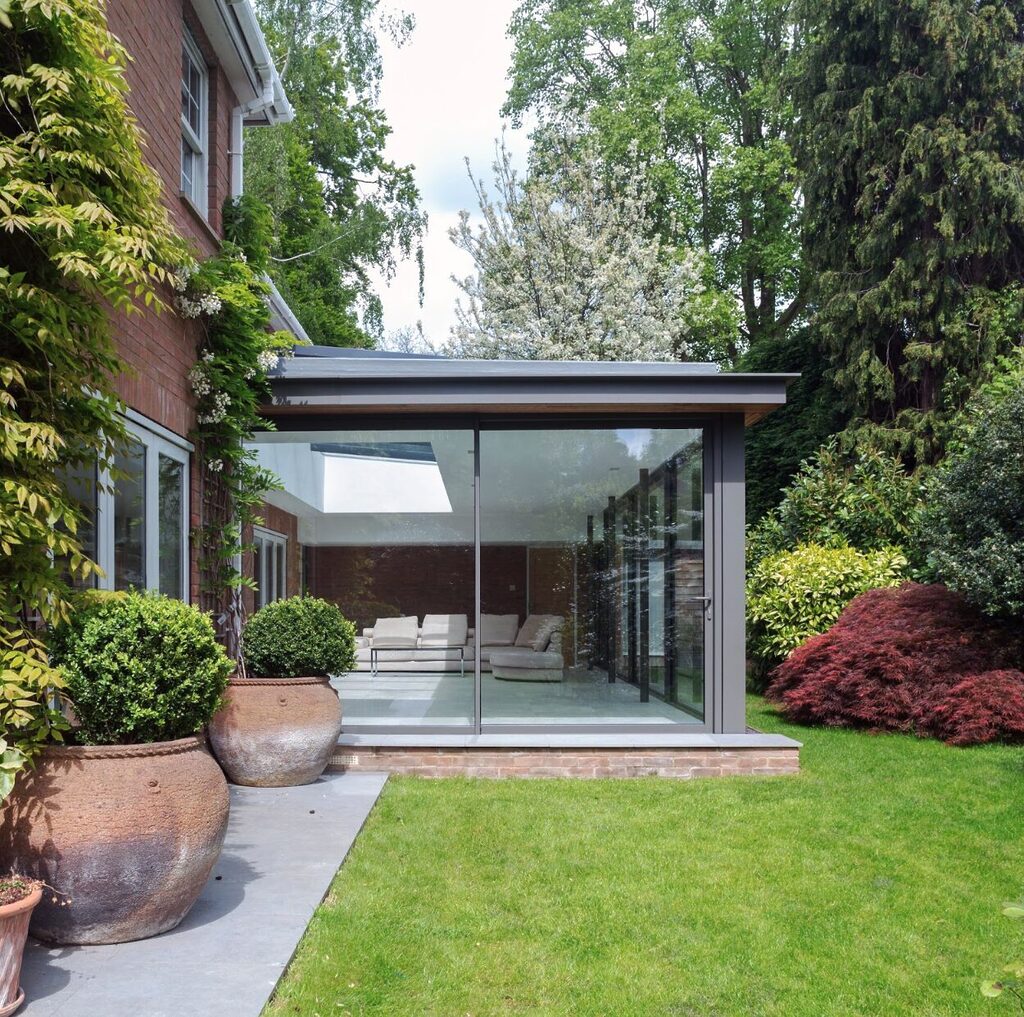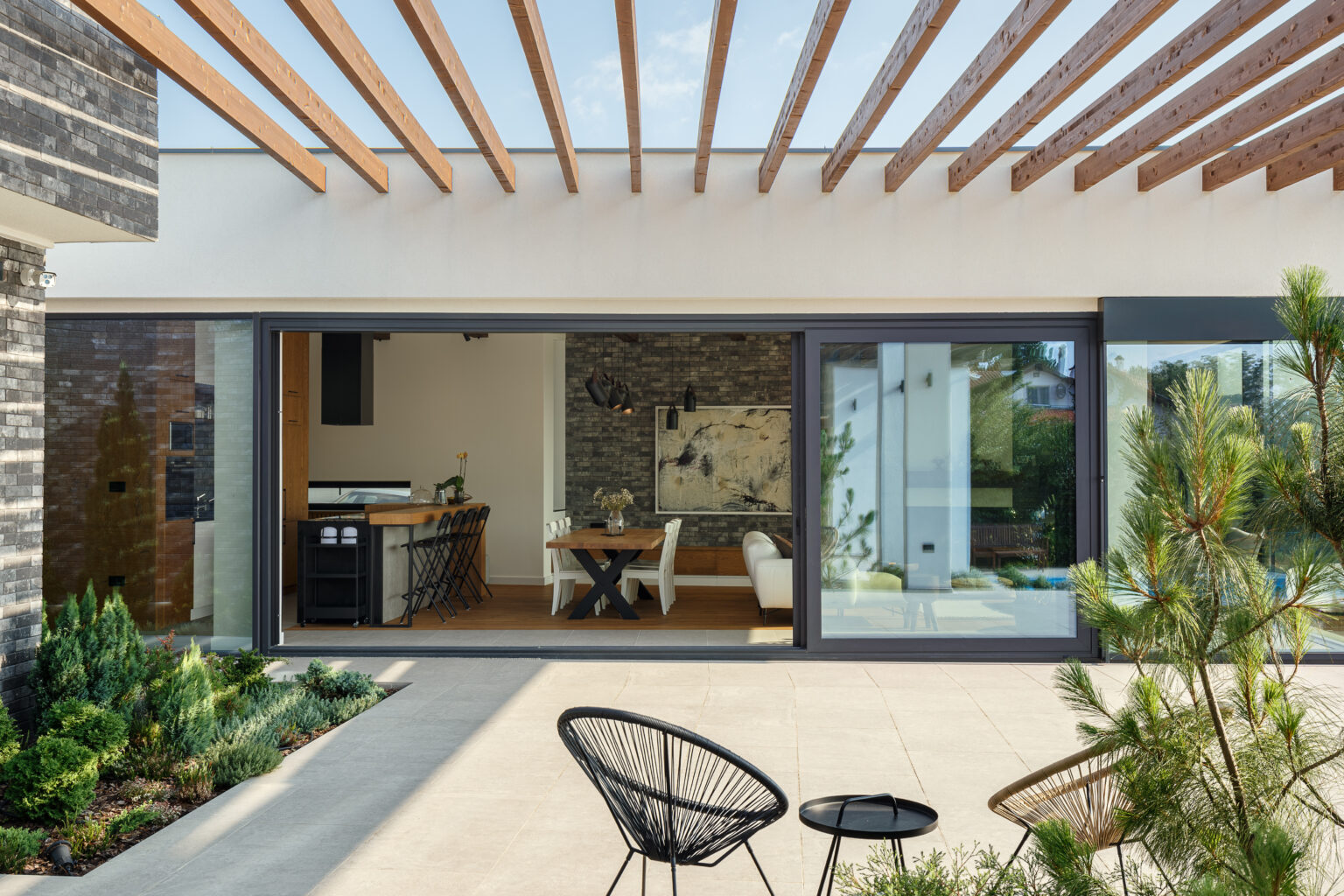Last Updated on 8 October 2024 by Tia Ellahi
Adjusting a sliding glass door: How do you do it?
Adjusting a sliding glass door can be a tricky task and involves several key steps: first, check the rollers; then adjust the height and alignment; add lubricant if necessary; and finally, test the door’s operation.
Sliding glass doors are a popular feature in many homes, offering easy access to outdoor spaces and providing plenty of natural light. However, over time, these doors can become difficult to open and close.
In this guide, we’ll walk you through the process of adjusting your sliding glass door to ensure it operates smoothly and securely.
In a hurry? Jump ahead:
- What is a sliding glass door?
- Why would you need to adjust your sliding glass door?
- Tools you’ll need
- How to adjust glass sliding door step-by-step
- When to invest in new glass sliding doors
- FAQs
What is a sliding glass door?
A sliding glass door, also known as a patio door or sliding door, consists of large glass panels that slide horizontally along a track. These doors are typically used to provide access to patios, decks, or other outdoor areas. Sliding glass doors offer several benefits:
- Space-saving: Unlike traditional hinged doors, sliding doors do not require extra space to open, making them ideal for small areas.
- Natural light: The large glass panels allow ample natural light to enter the home, enhancing the interior ambiance.
- Outdoor views: Sliding doors provide unobstructed views of the outdoors, connecting indoor and outdoor spaces seamlessly.
- Ventilation: When open, sliding doors can facilitate better air circulation in the home.
Why would you need to adjust your sliding glass door?
There are several reasons why your sliding glass door may need adjustment:
- Difficulty in opening or closing: If your sliding door is hard to open or close, it could be due to dirt and debris in the track or issues with the rollers. This can make everyday use frustrating and inconvenient.
- Misalignment: Over time, the door can become misaligned due to settling of the house or frequent use. Misalignment can cause the door to stick or not close properly, posing a security risk.
- Wear and tear: Regular use can lead to wear on the rollers, track, and other components, necessitating adjustment or replacement. Ensuring these parts are in good condition can prolong the life of your door.
Addressing these issues not only improves functionality but also enhances the security of your home.

Tools you will need
Before you begin, gather the following tools:
- Phillips screwdriver (or allen key depending on the product): Essential for adjusting screws on the rollers and lock mechanism.
- Flathead screwdriver: Useful for prying off caps and other small components.
- Adjustable wrench: Helps with more stubborn bolts and adjustments.
- Vacuum cleaner or broom: For cleaning out the track thoroughly.
- Lubricant (silicone-based is recommended): To ensure smooth operation of the track and rollers.
- Clean cloth: For wiping down the track and rollers.
How to adjust glass sliding door step-by-step
Step 1: Clean the track
Start by cleaning the door track to remove any dirt or debris that may be hindering the door’s movement. A clean track is essential for the smooth operation of the sliding door.
- Remove loose dirt: Use a vacuum cleaner or broom to remove any loose dirt and debris from the track.
- Wipe down the track: Use a clean cloth to wipe down the track, ensuring it is free of any grime.
“Keeping the track clean is crucial for smooth operation. Regularly vacuuming and wiping down the track can prevent buildup that causes the door to stick,” advises Nick, one of our GFD Homes sliding door experts.
Step 2: Check the rollers
Next, examine the rollers, which are located at the bottom of the door. These allow the door to glide smoothly along the track.
- Remove the door: Lift the door off the track by tilting it towards you and carefully setting it aside.
- Inspect the rollers: Look for signs of wear and tear, such as cracks or flattened areas. If the rollers are damaged, they may need to be replaced.
- Clean the rollers: Wipe down the rollers with a clean cloth to remove any dirt and debris.

Looking for a door solution with expansive glass panels? Our Smart sliding doors are the perfect choice! Each pane can be as wide as 1.7m and as high as 2.5m.
Step 3: Adjust the height and alignment
Most sliding glass doors have adjustment screws located at the bottom or top of the door. These screws allow you to raise or lower the door to ensure it is aligned correctly with the frame.
- Locate the screws: These are usually covered by small caps that you can pry off with a flathead screwdriver.
- Adjust the screws: Use a Phillips screwdriver (or allen key depending on the product) to turn the adjustment screws . Turning them clockwise will raise the door, while turning them counterclockwise will lower it. Adjust until the door is properly aligned with the frame.
Step 4: Add lubricant if necessary
Apply a silicone-based lubricant to the track and rollers to ensure smooth operation. Avoid using oil-based lubricants as they can attract dirt and debris.
- Lubricate the track: Apply a thin layer of silicone-based lubricant along the length of the track.
- Lubricate the rollers: Apply lubricant to the rollers to reduce friction and ensure smooth movement.
“At GFD Homes, we recommend using a silicone-based lubricant for sliding doors as it doesn’t attract dirt and dust, ensuring long-lasting smoothness.”

Step 5: Test the door
After making adjustments, replace the door on the track and test its movement. It should slide smoothly without any sticking or wobbling.
- Reinstall the door: Carefully lift the door back onto the track and ensure it sits properly.
- Slide the door: Test the door by sliding it open and closed several times to check for smoothness.
Step 6: Adjust the lock
Ensure that the lock aligns correctly with the strike plate. A misaligned lock can compromise the security of your door.
- Check the alignment: Close the door and check if the lock aligns with the strike plate. If it doesn’t, the lock may need adjustment.
- Loosen screws: Loosen the screws holding the keeps and move it up or down as needed.
- Tighten screws: Once the lock aligns properly, tighten the screws to secure the strike plate.
Step 7: Final test
Perform a final test to ensure all adjustments are correct and the door operates smoothly and securely. This step ensures that all components are functioning as they should.
- Open and close the door: Slide the door open and closed several times to ensure smooth operation.
- Lock and unlock the door: Test the lock to ensure it aligns correctly and secures the door properly.
By following these steps, you can ensure that your sliding glass door remains functional and secure. Regular maintenance and timely adjustments can significantly extend the life of your door, keeping your home both beautiful and practical.

Thinking of replacing your sliding doors? Why not take a look at our other patio doors.
When to Invest in New Glass Sliding Doors
If your sliding glass door continues to give you trouble despite adjustments, it may be time to consider replacing it. Here are some signs that it’s time for a new door:
- Persistent difficulty in opening and closing: If the door remains difficult to operate even after cleaning and adjustments, it might be time for a replacement.
- Visible damage to the frame or glass: Cracks, chips, or other damage to the frame or glass can compromise the door’s integrity and efficiency.
- Inefficient insulation leading to drafts: If you notice drafts or increased energy bills, your sliding door may no longer be providing adequate insulation.
- Outdated or worn appearance: An old or worn-looking door can detract from your home’s aesthetic appeal.
Investing in a new sliding door can enhance your home’s appearance, security, and energy efficiency. So, if you’re looking for a new glass sliding door and need help finding the perfect match for your home, feel free to browse our collection.
At GFD Homes, we’re proud to offer some of the best glass sliding doors available on the market, all coming with a 10 year guarantee for peace of mind long after your purchase.
For more information or if you have any questions and would like some advice, please contact us on 01642 309576.
Still wondering ‘what are sliding doors’? Read our article for more information.
FAQs About Adjusting Sliding Glass Doors
How can I make my sliding glass door slide easier?
Regular cleaning, proper lubrication, and ensuring the rollers and track are in good condition can make your sliding glass door slide easier. Additionally, adjusting the door’s alignment and height can significantly improve its operation.
Do all sliding doors have adjustment screws?
Most modern sliding doors come with adjustment screws, but some older models might not. Check your door’s manual or manufacturer’s website for specifics. If your door lacks adjustment screws, you may need to consult a professional for help.
Where is the adjustment screw on a sliding glass door?
Adjustment screws are typically located at the bottom or top corners of the sliding door. They may be hidden under small plastic caps. Removing these caps will reveal the screws, which you can adjust with a Phillips screwdriver (or allen key depending on the product).
What can I use to lubricate sliding door tracks?
A silicone-based lubricant is ideal for sliding door tracks as it doesn’t attract dust and dirt, providing long-lasting lubrication. Avoid oil-based lubricants as they can cause buildup and further hinder the door’s movement.
